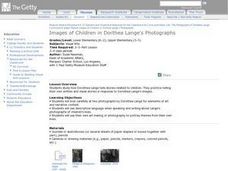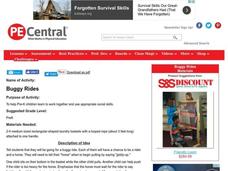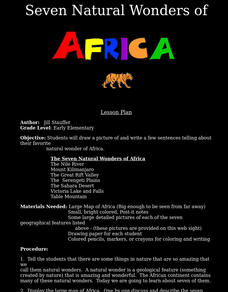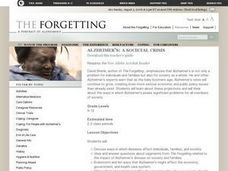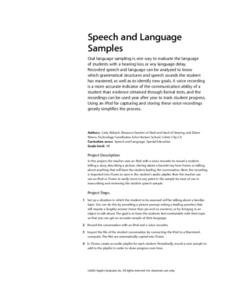Curated OER
Images of Children in Dorthea Lange's Photographs
Students research the photographs of Dorthea Lange. In this visual art lesson, students look at photographs of children taken by Lange and answer several questions. They write or tell stories to explain what they think is occurring in...
Curated OER
Through the Lens of Robert Capa
Students use Guided Reading techniques to learn about Capa's style and to discover the techniques that made him a great photographer. Students examine the basics of telling compelling stories through photos and each student creates a...
Curated OER
Enhancing Students' Problem-Solving Abilities
Students analyze the results of a hypothetical cloning experiment using a restriction endonuclease map obtained from an on-line data source. They answer the question, "How can I tell if the DNA I have obtained from this hypothetical...
Curated OER
Analyzing and Evaluating Holocaust Literature
Learners examine the history of the Holocaust through literature. Using different pieces of literature, they critique the items in terms of being historical accurate and its value in telling the stories of the Holocaust. They create a...
Curated OER
Tall Tales and Urban Legends
Students identify and interpret what tall tales, urban legends, and cyberlore are and to find them in their own lives. They practice telling and listening to these types of tales and explore why people tell them. Students also identify...
Curated OER
Self Portraits
Students examine Charles-Antoine Coypel’s Self-Portrait and discover what he shows in that piece of artwork. In this self portrait lesson plan, students will study a self portrait and discuss what they notice about it and what they...
Curated OER
Pizzaz!...Story Boxes
Students tell stories, using an oral, free-flow method. The stories can then be literally transcribed or a retold version/interpretation of them can be written down after the telling. High-beginner ESL level. A terrific speaking skills...
Curated OER
What Artifacts Reveal About The Past
Middle schoolers take a closer look at artifacts to learn about the people who used them. In this colonial America lesson, students examine photographs of everyday items used in colonial times and determine what the uses of the...
Curated OER
The First Fire : A Cherokee Animal Tale
Fourth graders discover movement through the telling of "The First Fire", a Cherokee tale. Small groups are given sections of the story to tell by creating dances. Music (live and recorded) adds to the final performance and assessment.
Curated OER
Cool Cars
Students travel one at a time in a straight-line path and attempt to maintain a constant velocity. While one student walks, jogs, or runs, the other group members time the "runner" while standing at five-meter intervals along the path....
Curated OER
Buggy Rides
Students go for a buggy ride. Each of them have a chance to be a rider and a horse. They need to tell their "horse" when to begin pulling by saying "giddy-up." students work together and use appropriate social skills
Curated OER
Seven Natural Wonders of Africa
Young scholars draw a picture and write a few sentences telling about their favorite natural wonder of Africa. They discuss the importance of the Nile River, Mount Kilimanjaro, the Great Rift Valley, the Serengeti Plains, and the Sahara...
Curated OER
What is Prejudice?
Students tell who Rosa Parks was and what she did to become famous and what state she did it in, and who Martin Luther King Jr. was, why he was important in history, and how we was connected with Rosa Parks.
Curated OER
Alzheimer's: A Societal Crisis
Students discuss ways in which diseases affect individuals, families, and society, and view and answer questions about segments from The Forgetting related to the impact of Alzheimer's disease on society and families. They brainstorm...
Curated OER
Speech and Language Samples
Students tell a story, describe a picture, share about a favorite toy from home and are recorded using an iPod with a voice recorder. They create a playlist of their voice and reading samples to illustrate progression over time.
Curated OER
Let's Summarize!
Students, after brainstorming what summarization is, practice the strategy of summarization to help pick out the important parts of text each time they read. They read and summarize the article, "10 Cool Things About Dolphins," from the...
National First Ladies' Library
Politics! Politics! The Emergence of Political Parties in the U.S.
High schoolers are split into six small groups which focus on one of six websites, that tell the story of the emergence of the Federalist and Democratic-Republican parties at the end of the 18th century. They compile a chronological list...
Curated OER
Everything was up to date in 1628
Students view a video of Colonial House, a reality series where people lived according to the standards of European immigrants to the U.S. in 1628. For this colonial history lesson, students research changes in geographic areas over time...
Curated OER
Survival Kit
Students discuss how a strong community can be helpful for survival during hard times. In this Survival Kit art activity, students create their own Survival Kit. Students use various items to symbolize things needed for survival in day...
Curated OER
An Honest Cigarette Ad?
Students recognize the intended audience for a certain advertisement They recognize advertising techniques aimed at the intended audience and create their own advertisements about the truth of cigarette smoking. Students begin to see...
Curated OER
New Year's Etymology and Writing Activity
Students investigate the history and etymology of New Year's Day. They listen to a teacher-led lecture about the background of New Year's Day, design an image of Janus, and write a story in the first person telling what Janus might say...
Curated OER
Invention Timeline
In this lesson, students Create a timeline of historical events, Identify patterns of change, Interpret data in a timeline.In this lesson, students use Inspiration to view progress over time as they develop
timelines highlighting...
Curated OER
How are Seeds Alike and Different?
Second graders examine the seeds in fresh fruit. In this seeds lesson, 2nd graders view different seeds and tell how they are alike and different. Students separate the seeds into groups according to their characteristics.
Curated OER
At Play
Ninth graders evaluate works of Robert Harris. They apply historical methodology to interpret and understand time, continuity, and change at an age appropriate level. They demonstrate awareness of the effect of context.
Other popular searches
- Telling Time Lesson
- Calendar Telling Time
- Telling Time Analog
- Spanish Telling Time
- Telling Time to the Half Hour
- Telling Time Clocks
- Telling Time Worksheets
- Telling Time to the Hour
- Telling Time to the Minute
- Telling Time Hour
- Telling Time Minute
- Telling Time Lesson Plans
